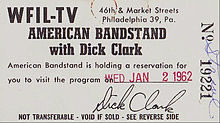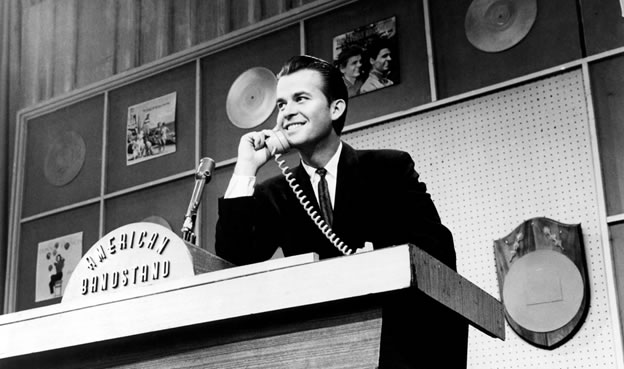Tribute to Dick Clark – Founder of American Bandstand
 Dick Clark (1929-2012) is an American music-performance show that aired in various versions from 1952 to 1989 and was hosted from 1956 until its final season by Dick Clark, who also served as producer. The show featured teenagers dancing to Top 40 music introduced by Clark; at least one popular musical act—over the decades, running the gamut from Jerry Lee Lewis to Run–D.M.C.—would usually appear in person to lip-sync one of their latest singles. Freddy “Boom Boom” Cannon holds the record for most appearances at 110.
Dick Clark (1929-2012) is an American music-performance show that aired in various versions from 1952 to 1989 and was hosted from 1956 until its final season by Dick Clark, who also served as producer. The show featured teenagers dancing to Top 40 music introduced by Clark; at least one popular musical act—over the decades, running the gamut from Jerry Lee Lewis to Run–D.M.C.—would usually appear in person to lip-sync one of their latest singles. Freddy “Boom Boom” Cannon holds the record for most appearances at 110.
The show’s popularity helped Dick Clark become an American media mogul and inspired similar long-running music programs, such as Soul Train and Top of the Pops. Clark eventually assumed ownership of the program through his Dick Clark Productions company.
American Bandstand premiered locally in late March 1950 as Bandstand on Philadelphia television station WFIL-TV Channel 6 (now WPVI-TV), as a replacement for a weekday movie that had shown predominantly British films. Hosted by Bob Horn as a television adjunct to his radio show of the same name on WFIL radio, Bandstand mainly featured short musical films produced by Snader Telescriptions and Official Films, with occasional studio guests. This incarnation was an early predecessor of sorts of the music video shows that became popular in the 1980s, featuring films that are themselves the ancestors of music videos.
Horn, however, was disenchanted with the program, so he wanted to have the show changed to a dance program, with teenagers dancing along on camera as the records played, based on an idea that came from a radio show on WPEN, The 950 Club, hosted by Joe Grady and Ed Hurst. This more-familiar version of Bandstand debuted on October 7, 1952 in “Studio ‘B’,” which was located in their just-completed addition to the original 1947 building in West Philadelphia (4548 Market Street), and was hosted by Horn, with Lee Stewart as co-host until 1955. Stewart was the owner of a TV/Radio business in Philadelphia and even though he was an older gentleman, his advertising account was a large one for WFIL-TV at the time and was put on the program to appease the account. As WFIL grew financially and the account became less important, Stewart wasn’t needed and was eventually dropped from the program. Tony Mammarella was the original producer with Ed Yates as director. The short Snader and Official music films continued in the short term, mainly to fill gaps as they changed dancers during the show—a necessity, as the studio could not fit more than 200 teenagers.
On July 9, 1956, Horn was fired after a drunk-driving arrest, as WFIL and dual owner Walter Annenberg’s The Philadelphia Inquirer at the time were doing a series on drunken driving. He was also reportedly involved in a prostitution ring and brought up on morals charges. Horn was temporarily replaced by producer Tony Mammarella before the job went to Dick Clark permanently.
In late spring of 1956, the ABC television network asked their O&O’s and affiliates for programming suggestions to fill their 3:30 p.m. (ET) time slot (WFIL had been pre-empting the ABC programming with Bandstand). Clark decided to pitch the show to ABC president Thomas W. Moore, and after some badgering the show was picked up nationally, becoming American Bandstand on August 5, 1957. One show from this first season (December 18, 1957, indicated as the “Second National Telecast”) is now in the archives of Chicago’s Museum Of Broadcast Communications.
“Studio ‘B'” measured 80’x42’x24’, but appeared smaller due to the number of props, television cameras, and risers that were used for the show. It was briefly shot in color in 1958 when WFIL-TV began experimenting with the then-new technology. Due to a combination of factors that included the size of the studio, the need to have as much space available for the teenagers to dance, and the size of the color camera compared to the black-and-white models, it was only possible to have one RCA TK-41 where three RCA TK-10s[3] had been used before. WFIL went back to the TK-10s two weeks later when ABC refused to carry the color signal and management realized that the show lost something without the extra cameras.
Program features
Rate-a-Record
Clark would often interview the teenagers about their opinions of the songs being played, most memorably through the “Rate-a-Record” segment. During the segment, two audience members each ranked two records on a scale of 35 to 98, after which the two opinions were averaged by Clark, who then asked the audience members to justify their scores. The segment gave rise, perhaps apocryphally, to the phrase “It’s got a good beat and you can dance to it.” In one humorous segment broadcast for years on retrospective shows, comedians Cheech and Chong appeared as the record raters.
Featured artists typically performed their current hits by lip-syncing to the released version of the song.
Hosts
The only person to ever co-host the show with Dick Clark was Donna Summer, who joined him to present a special episode dedicated to the release of the Casablanca film Thank God It’s Friday on 27 May 1978. From the late 1950s and most of the 1960s, Clark’s on-camera sidekick was announcer Charlie O’Donnell, who later went on to announce Wheel of Fortune and other programs hosted or produced by Clark, such as The $100,000 Pyramid. During this time, there were occasionally shows that were not hosted by Clark, in which case a substitute host (among them being Rick Azar) would be brought in to host in Clark’s stead.
Theme music
Bandstand originally used “High Society” by Artie Shaw as its theme song, but by the time the show went national, it had been replaced by various arrangements of Charles Albertine’s “Bandstand Boogie,” including Larry Elgart’s big-band recording remembered by viewers of the daily version. From 1969 to 1974, “Bandstand Theme,” a synthesized rock instrumental written by Mike Curb, opened each show. From 1974 to 1977, there was a newer, orchestral disco version of “Bandstand Boogie,” arranged and performed by Joe Porter, played during the opening and closing credits.
From 1977 to the end of its ABC run in 1987, the show opened and closed with Barry Manilow’s rendition of “Bandstand Boogie,” which he originally recorded for his 1975 album Tryin’ to Get the Feeling. This version introduced lyrics written by Manilow and Bruce Sussman, referencing elements of the series. The previous theme was retained as bumper music.
The Manilow version was replaced by an updated instrumental arrangement of “Bandstand Boogie” when Bandstand went into syndication, arranged by David Russo.
From 1974 to the end of the ABC run in 1987, Bandstand featured another instrumental at its mid-show break: Billy Preston’s synth hit “Space Race.”
Changes to Bandstand
Early changes
 When ABC picked up the game show Do You Trust Your Wife? from CBS in November 1957, they renamed the program as Who Do You Trust? and scheduled the program at 3:30PM ET—almost in the middle of Bandstand. Instead of shortening or moving Bandstand, ABC opted to just begin Bandstand at 3PM, cut away to Who Do You Trust? at 3:30PM, then rejoin Bandstand at 4PM. In Philadelphia, however, WFIL opted to tape-delay the game show for later broadcast in another time slot, and to continue on with Bandstand, though only for the local audience.
When ABC picked up the game show Do You Trust Your Wife? from CBS in November 1957, they renamed the program as Who Do You Trust? and scheduled the program at 3:30PM ET—almost in the middle of Bandstand. Instead of shortening or moving Bandstand, ABC opted to just begin Bandstand at 3PM, cut away to Who Do You Trust? at 3:30PM, then rejoin Bandstand at 4PM. In Philadelphia, however, WFIL opted to tape-delay the game show for later broadcast in another time slot, and to continue on with Bandstand, though only for the local audience.
A half-hour evening version of American Bandstand aired on Monday nights from 7:30 p.m. to 8:00 p.m. (ET), beginning on October 7, 1957. It preceded The Guy Mitchell Show. Both were ratings disasters. Dick Clark later stated that he knew the prime-time edition would fail because its core audience — teenagers and housewives — was occupied with other interests in the evenings. The Monday-night version aired its last program in December 1957, but ABC gave Clark a Saturday-night time slot for The Dick Clark Saturday Night Beech-Nut Show, which originated from the Little Theatre in Manhattan, beginning on February 15, 1958. The Saturday show would run until 1960.
The program was broadcast live, weekday afternoons and, by 1959, the show had a national audience of 20 million. In the fall of 1961, ABC truncated American Bandstand’s airtime from 90 to 60 minutes (4:00–5:00pm ET), then even further as a daily half-hour (4:00–4:30pm ET) program in September 1962; beginning in early 1963, all five shows for the upcoming week were videotaped the preceding Saturday. The use of videotape allowed Clark to produce and host a series of concert tours around the success of American Bandstand and to pursue other broadcast interests. On September 7, 1963, the program was moved from its weekday slot and began airing weekly every Saturday afternoon, restored to an hour, until 1989.
Move from Philadelphia to Los Angeles
Production of the show moved from Philadelphia to the ABC Television Center in Los Angeles (now known as The Prospect Studios) on February 8, 1964, which coincidentally was the same weekend that WFIL-TV moved from 46th and Market to their then-new facility on City Line Avenue. The program was permanently in color from September 9, 1967. The typical production schedule consisted of videotaping three shows on a Saturday and three shows on a Sunday, every six weeks. The shows were usually produced in either Stage 54 or Stage 55 at ABC Television Center.
For a brief time in 1973, Bandstand alternated its time slot with Soul Unlimited, a show featuring soul music that was hosted by Buster Jones. Soul Unlimited was not well-received among its target audience of African-Americans, ostensibly due to its being created by a white man (Clark), and because of its alleged usage of deliberately racial overtones despite this fact. Don Cornelius, the creator and host of Soul Train, along with Jesse Jackson, entered into a dispute with Clark over this upstart program, and it was canceled within a few weeks. Set pieces from Soul Unlimited were utilized by Bandstand for its 1974–1978 set design. During the 1978 season of Bandstand, Donna Summer became the only music artist in Bandstand’s history to co-host the program.
Move from ABC to syndication and the USA Network
As Bandstand moved towards the 1980s, the ratings began to decline. Many factors were involved in this, particularly the launch of MTV and other music programs on television, and along with that, the number of ABC affiliates opting to pre-empt or delay the program. The increase in competition hurt Bandstand and the variety of options for music on TV decreased its relevance. The other reason was that American Bandstand was pre-empted on many occasions by televised college football games (which expanded greatly in number in the wake of a court-ordered deregulation in 1984) which were becoming huge ratings successes, as well as occasional special presentations (i.e. unsold game show pilots).
Making matters worse, for the 1986–87 season, ABC reduced Bandstand from a full hour to 30 minutes; at Clark’s request, the final ABC episode (with Laura Branigan performing “Shattered Glass”) aired on September 5, 1987. Two weeks later, Bandstand moved to first-run syndication, restored to its former hour length, and videotaped at KCET studios. The show’s new set was similar to that of Soul Train. Clark continued as host of the series, which primarily aired on NBC affiliates (including KYW-TV, in the show’s former Philadelphia base), from September 19, 1987 until June 4, 1988; it was distributed by LBS Communications.
After a ten-month hiatus, Bandstand moved to USA Network on April 8, 1989, with comedian David Hirsch taking over hosting duties. In another format shift, it was shot outdoors at Universal Studios Hollywood. Clark remained as executive producer. This version was canceled after 26 weeks, and its final show (with The Cover Girls performing “My Heart Skips a Beat” and “We Can’t Go Wrong”) aired on October 7, 1989.

